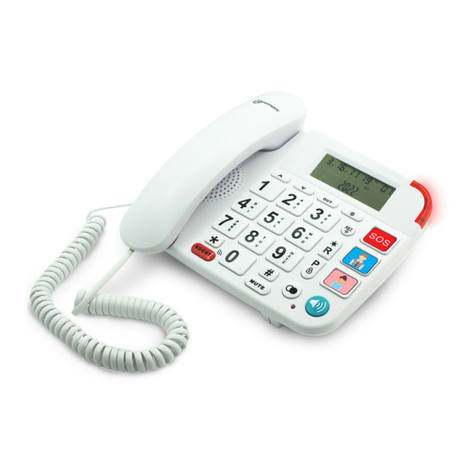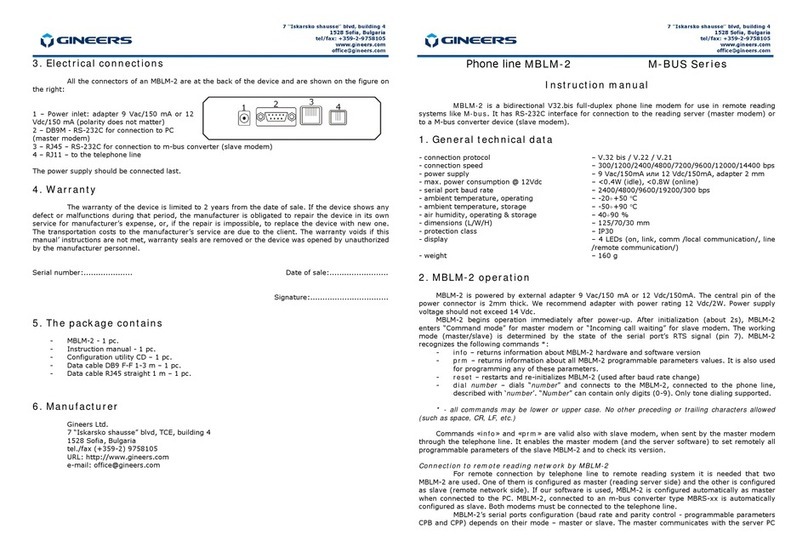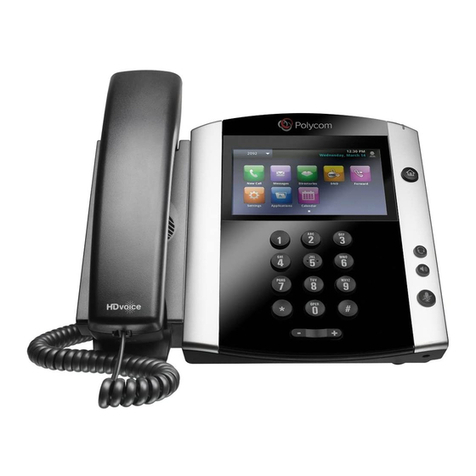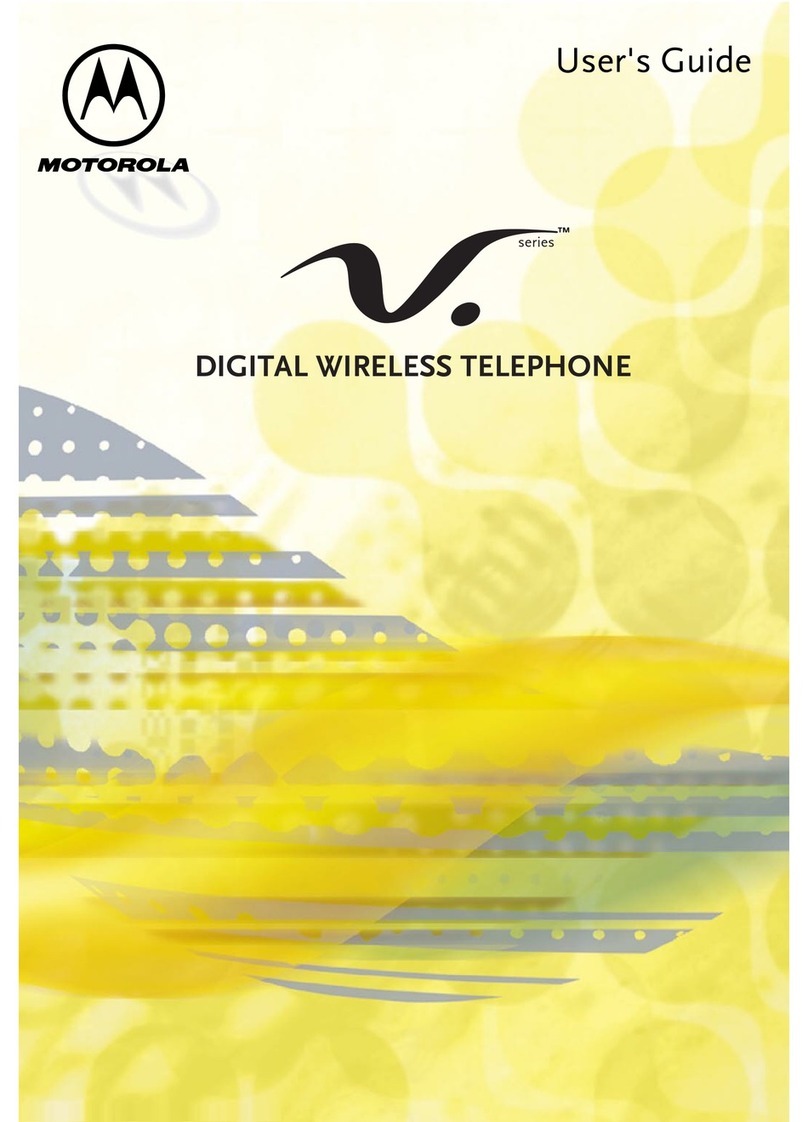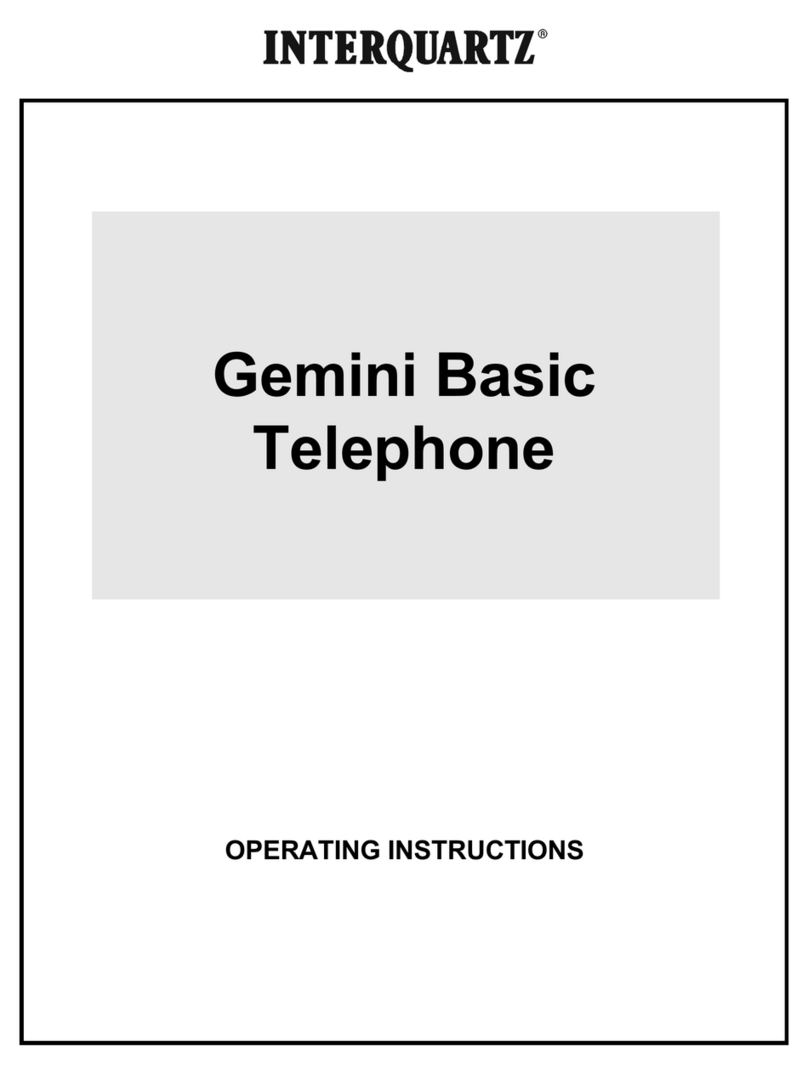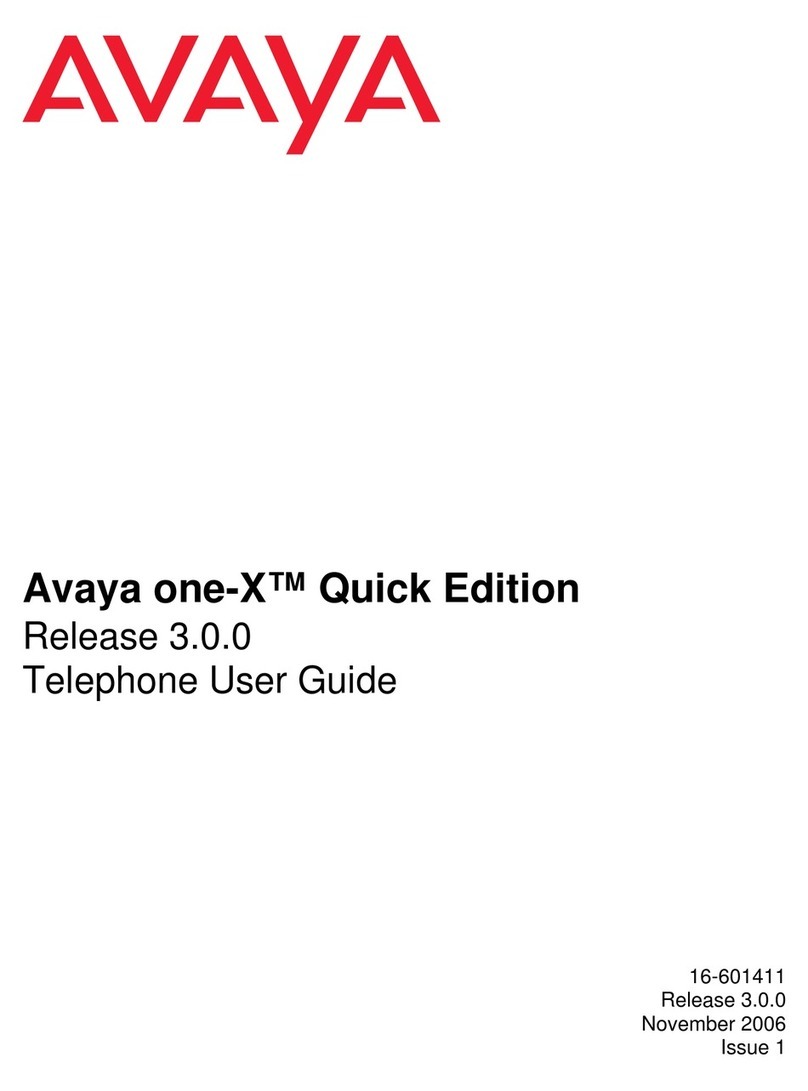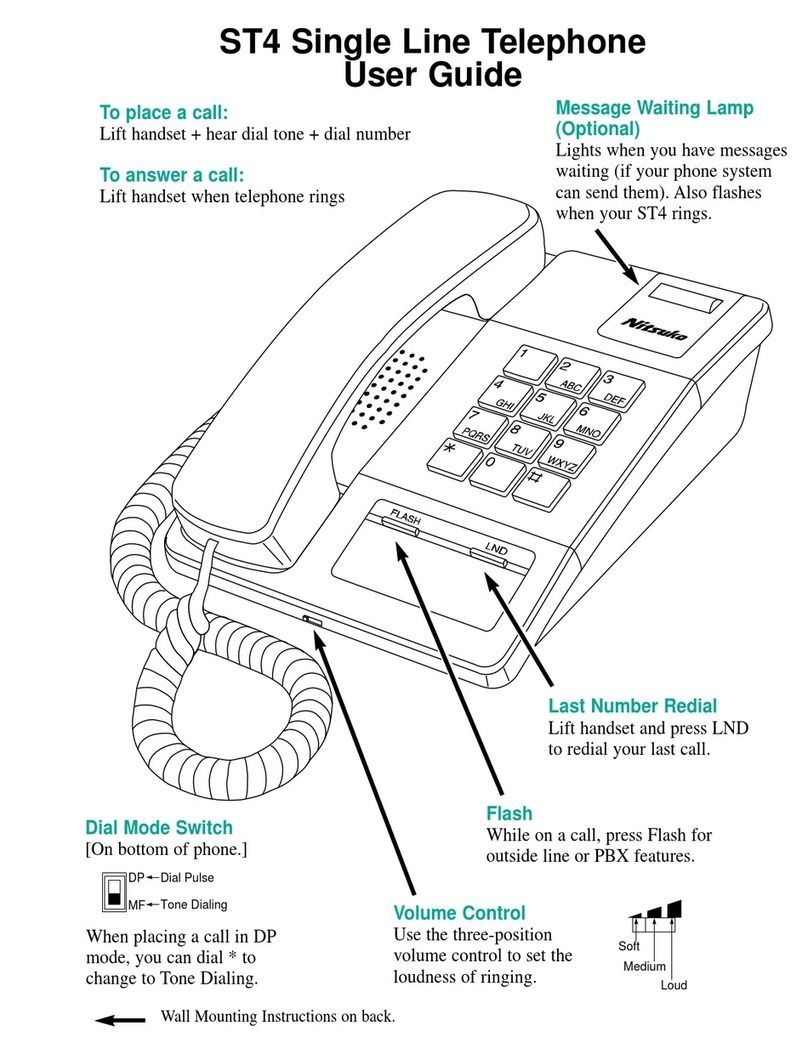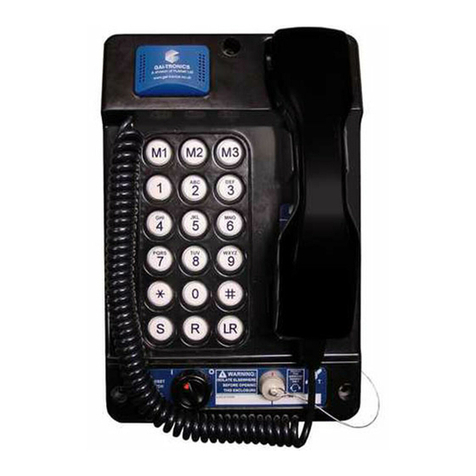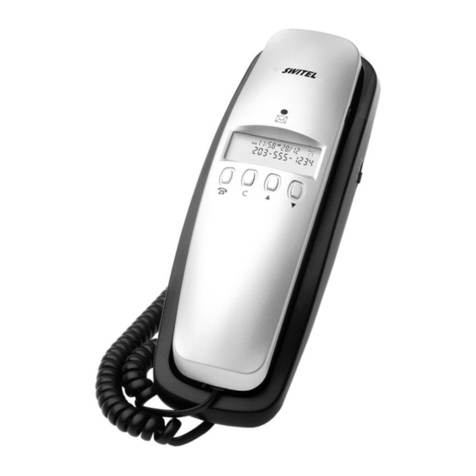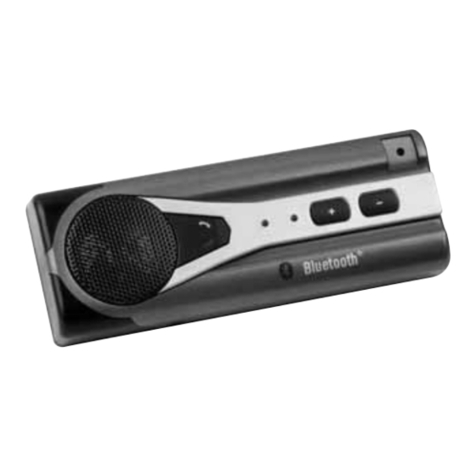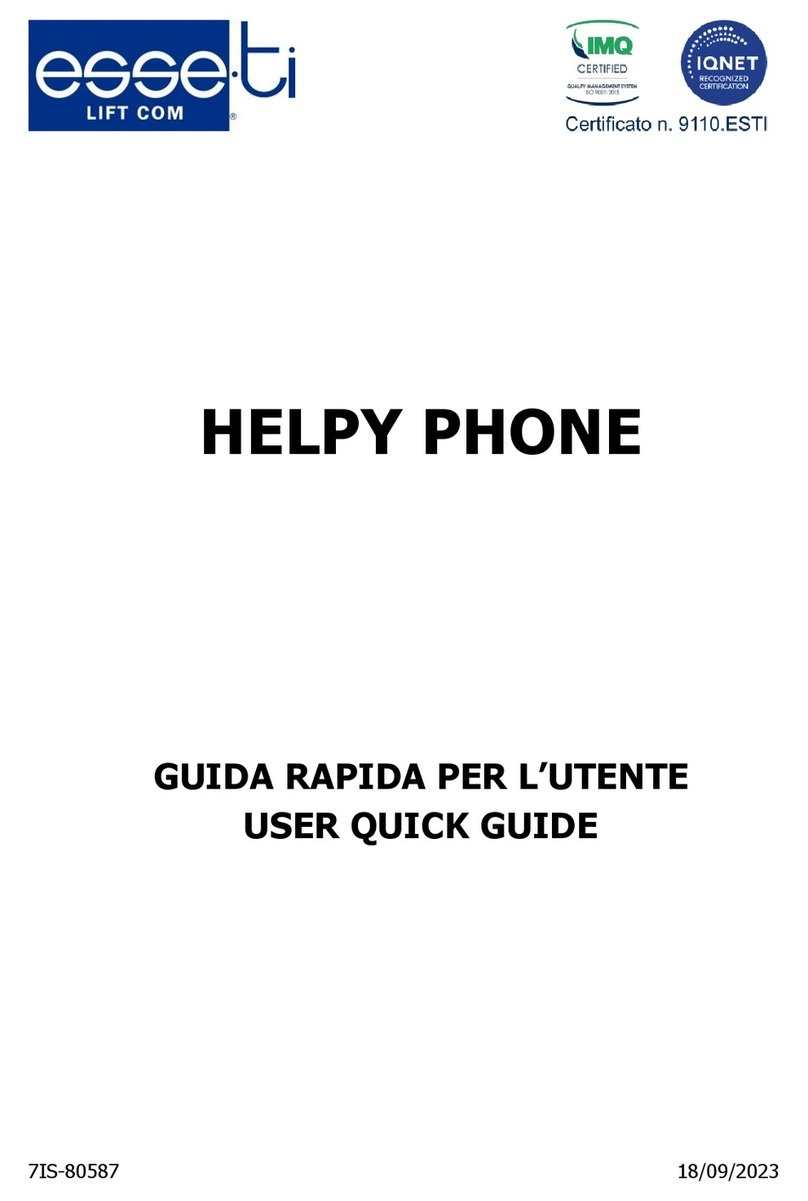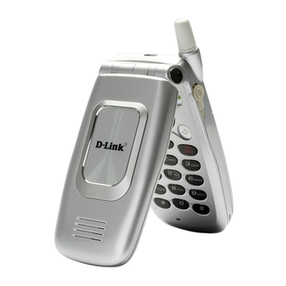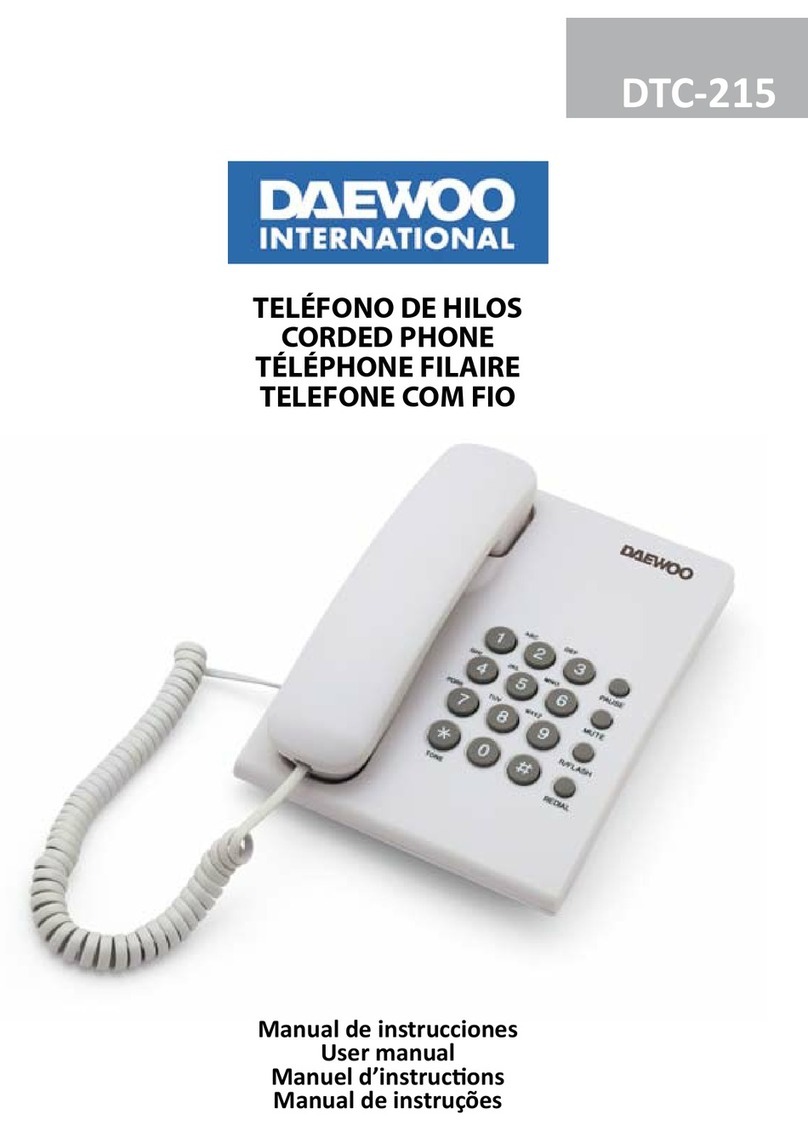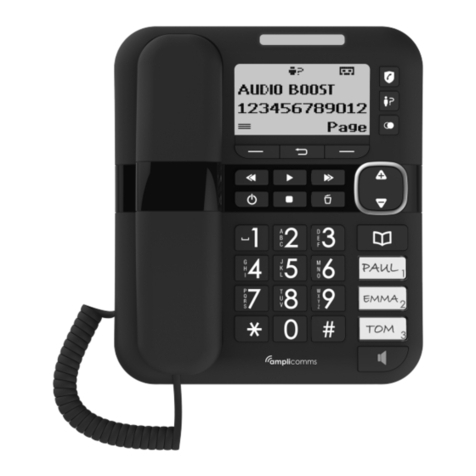ESI ivx e-class series Use and care manual

Administrator’s Manual
0450-0328
Rev. E

About ESI
ESI (Estech Systems, Inc.) is a privately held corporation based in Plano, Texas. Founded in 1987, ESI
designs and builds innovative telecommunications products for businesses like yours. Because of their
powerful combination of value and features, ESI products are consistently recognized by industry publi-
cations and leaders.
Copyright © 2005 ESI (Estech Systems, Inc.).
IVX is a registered trademark of Estech Systems, Inc. Ethernet is a registered trademark of Xerox Corporation. Motorola and
ColdFire are registered trademarks of Motorola, Inc. Rayovac is a registered trademark of Rayovac Corporation. Act! is a regis-
tered trademark of Symantec Corporation. Goldmine is a trademark of Goldmine Software Corporation. Microsoft, Windows, NT
and Outlook are registered trademarks of Microsoft Corporation. Panasonic and DBS are registered trademarks of Matsushita
Electric Corporation of America. Novell and Netware are registered trademarks of Novell, Inc. Smart Jack is a trademark of Westell
Technologies, Inc.
Information contained herein is subject to change without notice.
ESI products are protected by various U.S. Patents, granted and pending.
ESI is an ISO 9001-certified company. Visit ESI on the Web at www.esi-estech.com.

Table of contents
Administrator programming: An introduction......................................................................................................A.1
Administrator’s duties...................................................................................................................................................................................A.1
Telephone system features.........................................................................................................................................................................A.1
Voice mail features.......................................................................................................................................................................................A.2
ACD features................................................................................................................................................................................................A.2
Feature Phone overlays ..............................................................................................................................................................................A.2
Programming basics....................................................................................................................................................................................A.3
System programming overview..................................................................................................................................................................A.3
Programming keys.......................................................................................................................................................................................A.4
Entering alphanumeric characters..............................................................................................................................................................A.4
System fixed numbering plan......................................................................................................................................................................A.5
Remote setting of day, night, holiday and auto modes.............................................................................................................................A.5
Function 1: System parameters .............................................................................................................................B.1
Function 13: Administrator password.......................................................................................................................................................B.1
Function 14: System clock ..........................................................................................................................................................................B.1
Function 17: System speed-dial..................................................................................................................................................................B.3
Function 3: Extension programming.....................................................................................................................C.1
Function 32: Extension feature authorization.............................................................................................................................................C.1
Function 37: RFID programming................................................................................................................................................................C.3
Function 5: Voice mail programming ....................................................................................................................D.1
Function 53: Guest/info mailboxes .............................................................................................................................................................D.1
Function 54: Group mailboxes and the broadcast mailbox......................................................................................................................D.2
Function 55: Message notification ..............................................................................................................................................................D.3
Function 56: Cascade paging mailboxes...................................................................................................................................................D.4
Function 57: Q & A mailboxes ....................................................................................................................................................................D.5
Function 6: Recording.............................................................................................................................................E.1
Function 61: Re-record system and auto attendant branch prompts......................................................................................................E.1
Function 62: Record directory names ........................................................................................................................................................E.2
Function 63: Message-on-hold (MOH) programming...............................................................................................................................E.3
Function 7: Reports .................................................................................................................................................F.1
Function 73: ACD department detail report ...............................................................................................................................................F.1
Feature description: SMDR.................................................................................................................................... G.1
Tabular SMDR format.................................................................................................................................................................................G.1
CSV SMDR format......................................................................................................................................................................................G.1
Reporting conventions and rules...............................................................................................................................................................G.2
Index

(This page included for pagination purposes only.)

IVX E-Class Administrator’s Manual Administrator programming: An introduction
A.1
Administrator programming: An introduction
You can program ESI’s IVX E-Class system (IVX 128e or IVX 72e) locally or remotely from a 48-Key Digital
Feature Phone or 24-Key Digital Feature Phone while the system is operating. You also can program using
ESI’s Esi-Admin, a Windows-based software application your ESI Reseller can provide.
Read the E-Class User’s Guide first. Programming features require a clear understanding of user
interface and application.
Administrator’s duties
The SystemAdministrator can perform the following tasks:
• Administering station assignments
• Managing station feature authorization
• Maintaining the employee directory (if it’s used)
• Re-recording system prompts
• Administering manual change of Day/Night mode (if required)
User assistance
Each ESI phone system’s Verbal User Guide includes all of the information printed in the User’s Guide
(except for special features). Additionally, the ESI system users’ Web site, www.esiusers.com, includes
all the information in the User’s Guide, and more.
Telephone system features
• ESI Feature Phones — Compact and stylish,yet rugged, each 48- or 24-Key Digital Feature Phone
includes a high-quality speakerphone, large and informative multi-functional display and a specially
designed key layout with several dedicated keys to minimize or eliminate the need to memorize codes.
ESI also offers the 12-Key Digital Feature Phone,which is similar in design and basic functions.
• Extensive help — ESI’s Verbal User Guide™uses spoken and displayed help prompts to help
everyone from the Installer through the Administrator down to the least experienced end user. Help is
easily accessible with one press of either the HELP key on the 48-Key Feature Phone or the
PROG/HELP combo key on the 24-Key Feature Phone or 12-Key Feature Phone. One can also
visit www.esiusers.com for up-to-date help.
• Enhanced Caller ID — Allows one-touch automatic message return.1
• Live call recording — Can record any conversation or personal memo, with moving or copying of
any recording to another user’s voice mailbox (see “Voice mail features,” page A.2).
• Call waiting — Includes helpful display, showing both calls’ Caller ID information, and easy one-key
toggling between calls.
• Conference calling — Includes four conference bridges, and a conference may contain up to four
parties, so the IVX E-Class system can support four conferences of four parties each. Analog phones
on the system also may initiate conferences.
• Esi-Dex™speed-dialing — Calls any number using four separate lists (personal, station, system
and — when Esi-Link is in use — location); uses Caller ID1information or direct keypad entries.
• Dedicated overhead paging interface — Allows for external paging through overhead speakers or
multi-zone paging units (amplification required).
1This and all other references to Caller ID service within this manual assume the end-user organization subscribes to Caller ID
service from its telephone service provider.

Administrator programming: An introduction IVX E-Class Administrator’s Manual
A.2
• Intelligent call forwarding — Lets users of compatible PRI-equipped ESI systems view the original
Caller ID data of a call forwarded to an off-premises phone.
• 911 alert — Provides immediate line access if any station with line access dials 9 1 1 to report
an emergency; sends a message via the serial port indicating the start date, time, station number and
end-time of the 911; also sounds a warning tone at the operator station and displays, for example:
911 CALL FROM
X102 JOHN JAMES
Important: Don’t make 911 calls using Remote IP Feature Phones. Because a Remote Phone isn't con-
nected directly to its local telephone network, one must use a regular phone connected locally,
not the Remote Phone, to make 911 or other emergency calls.(For more information, see the
documentation included with the Remote Phone.)
• Status indicator lamp — Indicates three conditions of the 24- or 48-Key Digital Feature Phone:
off-hook, ringing and new voice mail message.
• Esi-Link support — Allows an multi-site enterprise to network any combination of up to 100 com-
patible ESI phone systems (or ESI IP Gateways) across an IP-based network.
• Optional NSP (Network Services Processor) — Allows system programming via TCP/IP and can
be adapted to fit a variety of phone system configurations, small to large.
• Optional VIP™— Provides an optional, value-added interface to an NSP-enabled IVX E-Class system.
Delivers call control and unified messaging to Microsoft®Outlook®2000/2002/2003.
• Optional IVX Presence Management — Provides integrated building entry control, access control,
status indication, personal call routing, and (optionally) time and attendance management. To learn
more, see www.esi-estech.com/presence.
Voice mail features
• Eight message-on-hold recordings — Among these are three prerecorded tracks; also supports
live entry.
• Message Recycle Bin (undelete) — Remembers, and can restore, each mailbox’s 10 most recently
deleted messages
• Quick Groups™— Makes it easy to leave voice mail messages for several users.
• Quick Move™— Records a conversation into another user’s mailbox.
• Virtual Mailbox Key™allows easy monitoring of a second mailbox.
ACD features
• Routes calls within designated departments for quickest possible call answering.
• Uses Digital Feature Phone display to provide up-to-the-second information on queues and wait times.
Feature Phone overlays
Each ESI Feature Phone comes with one overlay for the programmable feature keys. To order addi-
tional overlays, visit the DESI™Web site at www.desi.com. You can also download the free Windows®-
based software, DESI Lite, which allows you to print on the overlays. For assistance with DESI prod-
ucts, please consult the DESI Web site.
Tip: Remember that ESI’s Esi-Admin software, available from your ESI Reseller, also lets you print on the
overlays as well as perform other programming tasks.

IVX E-Class Administrator’s Manual Administrator programming: An introduction
A.3
Programming basics
As mentioned earlier, you may program from any ESI 48-Key Digital Feature Phone or 24-Key Digital
Feature Phone in the system. Here’s how:
1. Press PROGRAM. The normal station programming menu prompt will begin to play. Press HOLD
to stop the prompt.
2. Enter the Administrator password1, followed by #. You are now in programming mode (during this
time, the extension will be automatically placed in DND).
3. Follow the system programming menu to program as you wish; and, when finished, hang up.
Note: The system will automatically exit programming mode after 10 minutes of inactivity.
Example: If yourAdministrator password is 864, enter programming mode by pressing
PROGRAM HOLD 8 6 4 #
(To exit programming mode, hang up.)
System programming overview
Once you’ve accessed programming mode on an appropriate ESI Feature Phone, the system will
prompt for — and confirm — each keystroke action via voice commands and the display. You program
both configuration data and recordings in the same manner.
Important: During programming, the 24-Key Feature Phone’s two-line display shares the same content with
the top two lines of the 48-Key Feature Phone’s three-line display. Therefore, to save space, this
manual’s sample displays show only two lines.
Don’t program using a 12-Key Feature Phone; its single-line display cannot show some informa-
tion you’ll need during programming.
The following menu showsAdministrator programming functions available on the IVX E-Class system:
1 System parameters
13 Administrator password
14 System clock
Set time/date
Automatic time setting
17 System speed dial
3 Extension programming
32 Extension feature authorization
37 RFID programming2
371 Access schedules
372 RFID tag programming
373 View RFID tag numbers
374 IPM parameters
5 Voice mail programming
53 Guest/info mailboxes
54 Group mailboxes
55 Message notification options
551 Station delivery options
552 Delivery/paging parameters
56 Cascade paging mailboxes
57 Q & A mailboxes
6 Recording
61 Record system prompts
62 Record directory names
63 MOH programming
631 MOH source
632 Record MOH
633 MOH volume
7 Reports
73 ACD department report
74 Voice mail statistics report
75 System speed-dial list
1Default is 4 5 6.
2Valid only if your ESI phone system has IVX Presence Management. If administering such a system, refer to the IVX Presence
Management Administrator’s Manual (ESI part # 0450-0795).

Administrator programming: An introduction IVX E-Class Administrator’s Manual
A.4
Programming keys
During programming, the first line of the display will show the current item being programmed, and the
second line will be the entry line. You can enter values as directed by the combination of the voice
prompts and display. To enter multiple values, such as a list of extension numbers, separate each value
by #(to exit the list, enter # #).
To... Press ... What this does
Enter # Confirms new or existing entry and advances to next
programming step.
Back up (i.e.,
reverse direction)
Backs up to previous prompt without changing its value.
Delete HOLD Deletes data or recording.
Exit [Hang up] Exits programming mode and removes extension from DND.
Help HELP Provides more detailed instructions during programming.
(left-side
scroll key)
• During entry of a value, backs up.
• If a list is present (“>” is displayed), scrolls to left.
Select/scroll
(right-side
scroll key)
• Selects from options presented.
• If a list is present (“>” is displayed), scrolls to right.
• Inserts a space during entry of a name.
Note: Either <or >in the display indicates that additional choices orvalues are available by pressing a corre-
sponding scroll key (
or
).
Entering alphanumeric characters
You enter names for extensions and departments by pressing the dial pad key that corresponds to the
character to be entered. The key’s possible entries will change each time the key is pressed, and the
display will show this. When the desired character appears on the display, press #to confirm; the cursor
will move to the next character position. You may move the cursor left (to correct an entry) by pressing
the left scroll key (
) or move right (to add a space) by pressing the right scroll key (
).
Key Options Key Options
0 0, - (hyphen), _ (underline) 7 P, R, S, 7
1 Q, Z, 1, “_” (space) 8 T, U, V, 8
2 A, B, C, 2 9 W, X,Y, 9
3 D, E, F, 3
(left
scroll key) Backs up and erases
4 G, H, I, 4
(right
scroll key) Adds a space
5 J, K, L, 5 # [Enter]
6 M, N, O, 6 # # Ends the name
Example: To enter a B, press 2twice (the possible options to scroll through are A, B, C and 2). When Bis
displayed, press #to confirm; the cursor will move to the next character to be entered. To complete
the name, press # #.

IVX E-Class Administrator’s Manual Administrator programming: An introduction
A.5
System fixed numbering plan
Numbers Function Numbers Function
0 Operator 500 Broadcast mailbox
1–66 CO lines 501–516 Group mailboxes
100–183 User extensions 520–529 Cascade paging mailboxes
199 Overhead paging port 530–550 Recordable system prompts
290–299 Departmentnumbers 560–589 Feature codes
300–489 Guest/info mailboxes 590–598 MOH recordings
490–499 Q & A mailboxes 600–699 System speed dial
700–799 Esi-Link locations
Remote setting of day, night, holiday and auto modes
Normally, the system’s day/night mode operation will be manually controlled at an ESI Feature Phone
and/or set to follow the day/night mode tables (programmed by the Installer) automatically. In addition,
the Administrator can remotely change the mode and/or re-record the holiday greeting to handle unex-
pected closings such as for inclement weather.
Remotely logging into the system with the Administrator password lets the caller re-record the ID 1
greetings (day, night, day2 and night2) and the holiday greeting, as well as change the mode to
day/night/holiday/day2/night2 (or auto).
1. At the main greeting, enter
4 5 6 # — or
[the new password] #— to enter remote
programming mode.
2. You’ll hear prompts that will allow you to change the answer mode (day, night, day2, night2, holiday
or auto) and/or to re-record the holiday greeting and the main greeting (ID 1). Follow the prompts to
perform the desired operation.
3. Exit by pressing
and hanging up.
Prompts for remote settings: an outline
1 Set answer mode
1 Day mode
2 Night mode
3 Holiday mode
4 Use day/night table*
5 Day2 mode
6 Night2 mode
2 Record holiday main greeting
3 Record daytime main greeting
4 Record nighttime main greeting
5 Record day2 main greeting
6 Record night2 main greeting
Note: If the system is answered live and call is then routed to a mailbox., the Administratorcan press 8to
return to the main greeting and then follow the steps for making remote settings.
*This is used if the Installer has programmed an automatic calendar.

Administrator programming: An introduction IVX E-Class Administrator’s Manual
A.6
(This page included for pagination purposes only.)

IVX E-Class Administrator’s Manual Function 1: System parameters
B.1
Function 1: System parameters
Function 13: Administrator password
These functions will display the existing password and prompt for entry of a new password.The pass-
words can be 2–8 digits long, followed by #. The Installer can change either the Installer or
Administrator password. Only those functions listed in the Administrator Manual can be pro-
grammed via the Administrator password. The default Administrator password is 4 5 6.
Notes: You can use the Administrator password to access a user’s station programming.At the station, when
prompted for the user’s password, enter either the Administrator password, then follow normal user
programming procedures.
Accessing user station programming
Should a user forget his password or if an employee leaves the organization, this feature allows the
Installer or Administrator to enter a user's station programming and operate within it as if he were the
user. From the user’s station, enter the Administrator password when the system prompts for the
user password.
Example: From station 105, entering 4 5 6 # instead of the user password (1 0 5 #) willenter the station’s
user programming. (Default password shown for this example).
Function 14: System clock
Function 141: Set time/date
1. Enter a new time in a twelve-hour format.
Example: Enter 1 2 3 3 for 12:33, or 3 1 5 for 3:15 (note that you need no leading zero for the time).
2. Select AM or PM by pressing a scroll key (either
or
).
3. Enter a new date in an eight-digit format, including leading zeroes.
Example: Enter 0 7 0 4 2 0 0 3 for July 4,2003 (note that leading zeroes are required here, unlike in
Step 1).
4. Press #to finish the entry.
Note: A built-in battery maintains the correct time and date, even in the event of a power loss.

Function 1: System parameters IVX E-Class Administrator’s Manual
B.2
Function 142: Automatic time setting
1. Synchronize with CID
This function, when enabled, synchronizes the real-time clock with Caller ID (CID) messaging:
call processing compares the time of a CID message to the system real-time clock and, if the
difference is more than two minutes, resets the real-time clock to match the time (hours and
minutes) of the CID message. The system will analyze each such message (or — if it receives
more than four calls with CID information within a one-minute period — as is needed). Select
ENABLE or DISABLE by pressing a scrollkey (either
or
). Choosing ENABLE will allow
the CID data to update the time and date.
Default: Enabled.
Notes: If this function is enabled, Esi-Link time synchronization (from location 700) will be disabled.
If this function is disabled, Esi-Link time synchronization will be allowed (minutes only).
2. Adjust for Daylight Savings Time
This function, when enabled, causes the real-time clock to adjust itself automatically for Day-
light Savings Time (DST). Select AUTO or DISABLE for DST by pressing a scroll key (either
or
). Choosing DISABLE is best for those areas that don’t observe DST.
Default: Disabled.
Note: If this function is enabled and it causes an automatic time change, the system won’t update
the real-time clock from either Caller ID messages (Function 1421, above) or Esi-Link time
synchronization for 25 hours before and 25 hours after the time change is due to be effective
(i.e., 2:00 AM Sunday).

IVX E-Class Administrator’s Manual Function 1: System parameters
B.3
Function 17: System speed-dial
Up to 100 system speed dial names and associated numbers can be stored, in location numbers 600–699,
for access by any station. A user can initiate a system speed-dial by dialing the speed dial location number
or by accessing the name through the Esi-Dex feature. In Function 32, access to system speed-dial can
be denied to individual stations (see page C.1).
Note: System speed-dialing overrides toll restrictions (Function 32,page C.1).
1. Enter the 3-digit location number to program,
2. Enter a ten-character name (see “Entering alphanumeric characters,” page A.4).
3. Enter the number to be dialed (including the line group 9, 8, or 71–76). Press the left scroll key (
)
to delete any character or digit entered in error. Here’s an example:
1. 2. 3.
Speed-dial number Name Number
601 AUTO RENTL 915552221212
The number dialed in Step 3 can be up to 30 digits long including the following special codes:
Code What it produces
# # DTMF tone
DTMF tone
F Flash hook
P 2-second pause
Use the scroll key to enter special characters; use the
scroll key to backspace. Press #to confirm
the inserted character and continue. Press # # to complete the entry.
Example: To create a System Speed Dial number that dials 9, then 972-555-5644, then pauses for
four seconds and finally dials #104, enter:
9 9 7 2 5 5 5 5 6 4 4 (then scroll to) P # (then scroll to) P # (then scroll to) # # 1 0 4 #
Deleting a speed dial number
To delete an entire speed dial number and name, delete the location number (6 X X) by pressing HOLD
or the left scroll key (
) during Step 1 in the speed-dialing procedure described above.

Function 1: System parameters IVX E-Class Administrator’s Manual
B.4
(This page included for pagination purposes only.)

IVX E-Class Administrator’s Manual Function 3: Extension programming
C.1
Function 3: Extension programming
Important: Where any gray shading (■) appears in an example, it represents values either unavailable to
the function or unused in the particular example.
Function 32: Extension feature authorization
An Administrator can allow or deny many extension features on an extension-by-extension basis. A user,
however,can only program and use allowed features (by using a combination of voice and display prompts)
from his/her phone.
Below is an example of a completed Programming Worksheet. The programming sequence is:
1.
Ext.
2.
Name
3.
Call
wait
4.
DND
5.
AA
block
6.
Rec.
7.
Svc.
obs.
8.
Toll
allow
9.
Sys.
spd. dial
10.
Auto-
Page
11.
Ext.
fwdg.
12.
Fwdg. to
toll nos.
13.
Trunk-to-
trunk xfer
14.
Unified
msg.
XXX Default Y Y N Y N Y Y N N N N N
100 Jane Y Y N Y N Y Y Y N N N N
101 Roger Y Y N Y N Y Y N N N N N
102 Sally Y Y N N N Y Y Y N N N N
110*Bill Y N Y Y N N N N
The programming steps are:
1. Extension number — Enter the extension number to program.
2. Extension name — Name the extension (if it hasn’t previously been named by the Installer).
For each of the following features, press a scroll key (
or
) to select YES or NO.
3. Call waiting — Allows the user to turn call waiting on or off for his station.
4. Do not disturb — Allows the user to activate DND from his station.
5. Auto attendant block — Blocks calls from being transferred to the station from the auto attendant;
follows the extension’s call forward day/night as programmed by the Installer.
6. Live recording feature — If enabled, will allow the user to record conversations.
7. Service observing — Allows the user to monitor the conversations of those stations listed
in the service observing list for his/her station. If this is enabled, you must enter a list of allowed
extensions.
Note: A Department numbercan be entered as an extension in the Service Observing listand will then
automatically include allmembers of the Department even if the members of the Departmentare
later changed.
8. Toll restriction — “YES” allows the user to place toll calls. If you select “NO,” the user can make
only either non-toll calls or calls to numbers listed in the allow exception table.
9. System speed dial — “YES” allows the user to access and place system speed dial calls.
(Continued)
*An example of an analog phone.

Function 3: Extension programming IVX E-Class Administrator’s Manual
C.2
10. AutoPage — Lets the user turn AutoPage (defined below) on or off at his/her station.
Note: This feature is used in conjunction with the directory names recorded in Function 62 and is not ac-
tive until a directory name is recorded for the extension.
If the station user has his/her mailbox set to answer with personal greeting 3 and a caller presses 3
to page that user, this feature automatically pages the station user in the page zones entered in
Function 31. If no page zone is entered, all IVX Digital Feature Phones on the system are paged.
Default: Disabled.
Note: When AutoPage is enabled, the IVX E-Class system will use the last installed idle digital port to
perform the page. Therefore, ifa phone is on the last installed port, the phone’s user may experi-
ence a briefdelay in telephone operation if he/she picks up the handset (or presses SPEAKER)
during the AutoPage.
11. External forwarding — Allows the station user to use the call forwarding/off-premises and off-
premises “reach-me” features. See the User’s Guide for more information about these features.
Default: Disabled.
Note: After the system dials the external forwarding number, it will play a prompt saying, “You are receiv-
ing a forwarded call. Press any key to accept.” This prompt will play continuously for 30 seconds. If
the forwarded call is answered and the called person dials a digit, the forwarded call will be con-
nected to that person. If no digit is dialed, the caller is automatically forwarded to voice mail. While
the two lines (trunks) are connected, the system constantly monitors the line for open loop condi-
tions (hang-up). If an open loop is detected on either line, the call is disconnected. The system also
monitors for voice activity on the connected lines; if voice is no longer detected, the call is discon-
nected. Finally, if both lines are connected for more than 60 minutes1, the call will be disconnected.
12. Forwarding to toll numbers — This feature is used in conjunction with external forwarding (see
previous item). When enabled, this feature lets the user program a long-distance number for exter-
nal forwarding.
Default: Disabled.
(Continued)
1Default timer setting. To adjust this, contact ESI Technical Support.

IVX E-Class Administrator’s Manual Function 3: Extension programming
C.3
13. Trunk-to-trunk transfer — When enabled, this lets the station user initiate a trunk-to-trunk transfer.
The user, while connected to a CO line, can press TRANSFER, dial an off-site number and then
complete the trunk-to-trunk transfer by simply hanging up. Both outside parties are then connected.
A station user also can set up a conference call and then drop out of the conference, leaving the
other members conferenced.
This feature must be enabled for external call forwarding to succeed.
Default: Enabled.
Important: USE OF FEATURES, SUCH AS TRUNK-TO-TRUNK TRANSFER, THAT REQUIRE
TRUNK-TO-TRUNK CONNECTIONS WILL INCREASE THE RISK OF TOLL FRAUD. IN
NO EVENT SHALL ESI (ESTECH SYSTEMS, INC.) BE LIABLE FORANY DIRECT, INDI-
RECT, INCIDENTAL OR CONSEQUENTIAL DAMAGES WHATSOEVER INCLUDING,BUT
NOT LIMITED TO, FRAUDULENT TOLL CHARGES,LOSS OF BUSINESS PROFITS,
BUSINESS INTERRUPTIONS ORANY OTHER COSTS OR DAMAGES RELATED
THERETO ARISING FROM THE USE OF THESE FEATURES.
14. Unified messaging — Allows or denies VIP access. (For more information about VIP, consult your
ESI Reseller.)
Example: Here is a portion of a completed Programming Worksheet for extension feature authori-
zation. Note that:
• Extension 100 cannot record calls but can make toll calls (except those listed in the
deny table) and can access the system speed dial numbers.
• In comparison, Extension 102 cannot make general toll calls but also can call any
system speed dial number, even if it’s a toll call.
• (Extension 112 doesn’t have DND,AA block, record or service observing capability
because it’s an analog port.)
1.
Ext.
2.
Name
3.
Call
wait
4.
DND
5.
AA
block
6.
Rec.
7.
Svc.
obsv.
8.
Toll
allow
9.
Sys.
spd. dial
10.
Auto-
Page
11.
Ext.
fwdg.
12.
Fwdg.
to toll
nos.
13.
Trk-to-
trk xfer
14.
Unified
msg.
100 Jane Y Y N N N Y Y N N N N N
102 Sally Y Y N Y N N Y Y N N N N
112*Bill Y N Y Y N N N N
Function 37: RFID programming
This function relates to IVX Presence Management only, and covers several steps needed to:
• Program RFID tags.
• Access scheduling.
• View tag numbers.
• Set IVX Presence Management parameters.
For more information, see the IVX Presence Management Administrator’s Manual (ESI # 0450-0795).
*An example of an analog phone.

Function 3: Extension programming IVX E-Class Administrator’s Manual
C.4
(This page included for pagination purposes only.)

IVX E-Class Administrator’s Manual Function 5: Voice mail programming
D.1
Function 5: Voice mail programming
To simplify initial installation, all programmed extensions will automatically have the generic personal
greeting, “You have reached the mailbox for extension [xxx].”The mailbox user should replace this with
a personalized greeting. Each guest/info, group, cascade paging or Q & A mailbox must have a greeting
recorded for the IVX E-Class system to consider the mailbox active.
Important: A mailbox will not receive broadcast messages until a greeting has been recorded for it. Addi-
tionally: if the default greeting is deleted, the mailbox willbe considered inactive.
Function 53: Guest/info mailboxes
Mailboxes numbered 300–489 can be programmed as either a guest or info mailbox. Enter the mailbox
number and select Guest or Info by pressing a scroll (
or
) key.
Guest mailboxes
Guest mailboxes are designed to be used by personnel, such as in outside sales or manufacturing,
who do not have an extension assigned to them. A guest mailbox requires no programming other than
the assigning of a name.
Note: A guest mailbox can be handled like a regularextension (i.e., listed in the directory, assigned a station
key, etc.), and is password-protected by default.
If a programmable feature key is programmed as a virtual mailbox key with a guest mailbox number, the
key’s LED will blink, to indicate that new messages exist.1
To retrieve messages from a station, press VOICEMAIL
and then either press the DSS key or enter
the mailbox number. To record a greeting, press PROGRAM
and the mailbox number; then press #
to confirm, and follow the prompts; the default password is the mailbox number. To retrieve messages
from the outside, press
and the mailbox number during the Main Greeting.
Default: 300–489 as Guest.
Info mailboxes
Info mailboxes can be used to give callers information on a variety of different subjects by “publishing”
these mailbox numbers. Info Mailboxes are identical to Guest Mailboxes except that the caller will not
be given a record tone after the personal greeting (the information to be played). Instead, the caller will
be forwarded as programmed in this function (default is the caller will be disconnected after the informa-
tion is played). The maximum length of the record time is 14 minutes. Guest/info mailboxes are created or
deleted here, but are turned “on” only when a personal greeting (the information to be played) has been
recorded. Deleting the personal greetings will turn “off” the mailbox.
To record a greeting, press PROGRAM
and the mailbox number; then press #to confirm, and follow
the prompts; the default password is the mailbox number.
Below is an example of a completed Programming Worksheet, showing the sequence of programming:
1. 2. 3. 4. 5.
MB Name Type CF day CF night
400 Dana Guest
402 Literature Info MB 302 MB 302
1Otherwise, the key is a DSS key that allows for single-key transfer of a call with no message indication.

Function 5: Voice mail programming IVX E-Class Administrator’s Manual
D.2
Each programming step is defined as follows:
1. Mailbox number — Enter a mailbox number, 300–489.
2. Name — The mailbox name is used for the display, reports, and as a programming aid.The name
length can be no longer than 10 characters (see “Entering alphanumeric characters,” page A.4).
Default: The Mailbox number.
3. Type — Select a mailbox type: Guest or Info.
Default: Guest.
4. and 5. Call forward (info mailbox only) — An info mailbox can be set to call forward after the per-
sonal greeting has played to an extension, department, a mailbox or a branch ID for day mode and
differently for night mode.
Default: ID9999 (automatic disconnect).
Function 54: Group mailboxes and the broadcast mailbox
Broadcast mailbox
Mailbox 500, the broadcast mailbox, is a special group mailbox which can be used to leave messages
for all of the system’s station users (extensions 100–183) who have recorded a personal greeting. The
broadcast mailbox’s user list cannot be edited. Guest mailboxes are not included in the broadcast group.
Group mailboxes
You can assign up to 16 group mailboxes (501–516) to the IVX E-Class system; each group mailbox
can have up to 32 members. Anyone who knows the password can leave messages for all users listed
as members of that group and who have recorded a personal greeting. The Installer, Administrator or
group mailbox “owner(s)” may set or change the list of Group Mailbox members. To record a greeting,
press PROGRAM
and the mailbox number; then press #to confirm, and follow the prompts. The
default password is the mailbox number.
Important: A group mailbox is turned “on” (able to record and playback messages) only when its “owner”
has recorded a greeting for it, such as “This is the group mailbox forEast Coast RegionalSales.”
Similarly, deleting the group mailbox greeting will turn “off” the group mailbox; any outstanding
messages will remain in its members’ mailboxes until erased by each member.
Notes: If 0(zero) is programmed as the password, anyone can leave group messages or program the
Group Mailbox.
If a user saves a group message, it will be saved as a new message.
1. 2.
MB Group member mailboxes’ numbers
501 102 104 106 107 122 303 314
Here is the programming sequence:
1. Enter the group mailbox number — Range: 501–516.
2. Enter group member mailboxes’ numbers — Separate each by #; enter # # to end the list.
Range: User mailboxes (100–183) and guest mailboxes (300–489).
Table of contents
Other ESI Telephone manuals
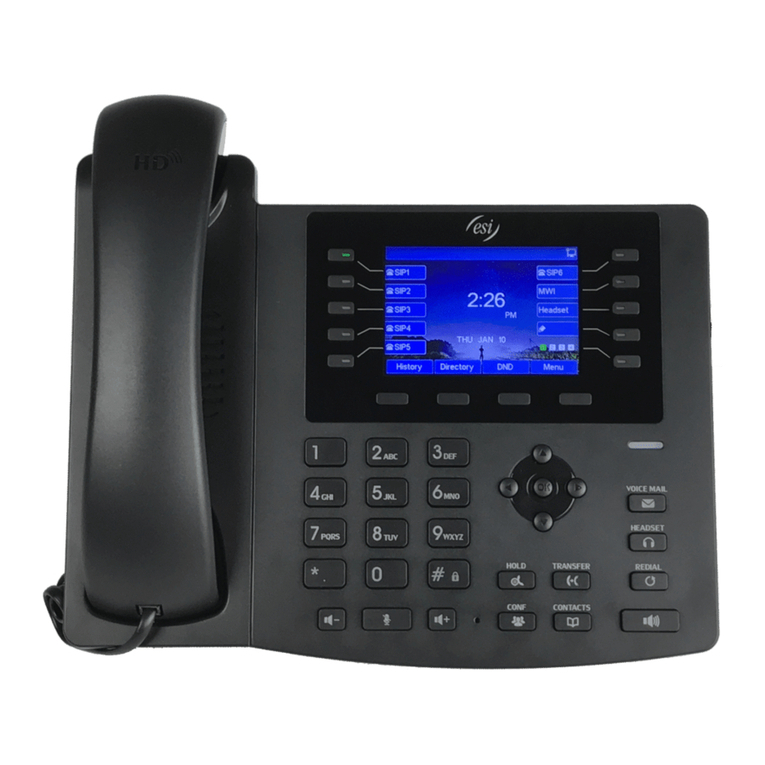
ESI
ESI ePhone8 User manual

ESI
ESI ESI Phone Specification sheet
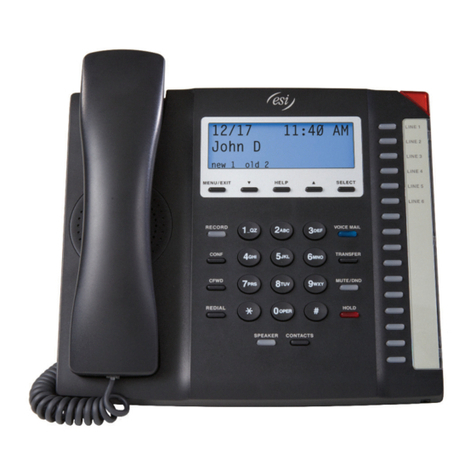
ESI
ESI 45SIP User manual

ESI
ESI 30D Business Phone User manual

ESI
ESI ePhoneX eSIP Evolution Series User manual
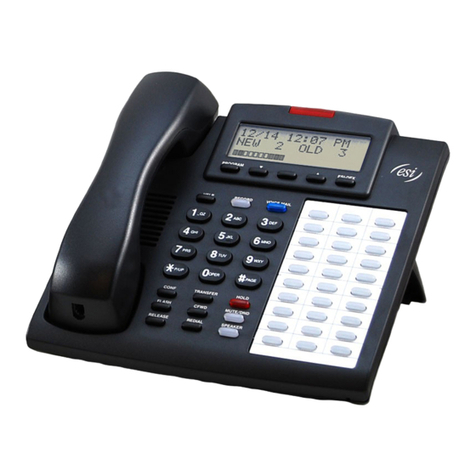
ESI
ESI IVX X-Class User manual
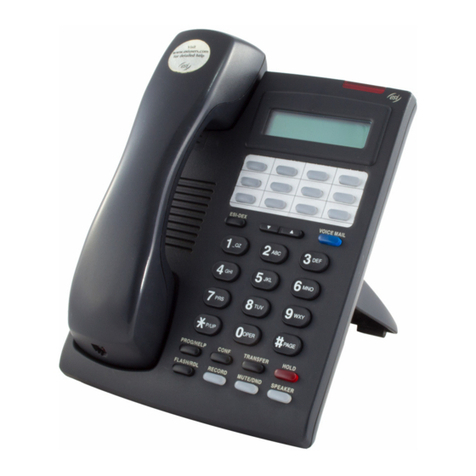
ESI
ESI IVX C-Class User manual
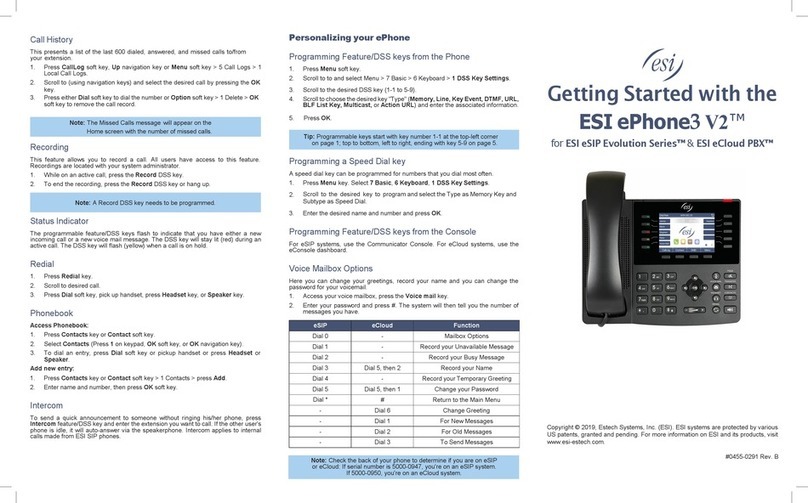
ESI
ESI ePhone3 V2 User manual
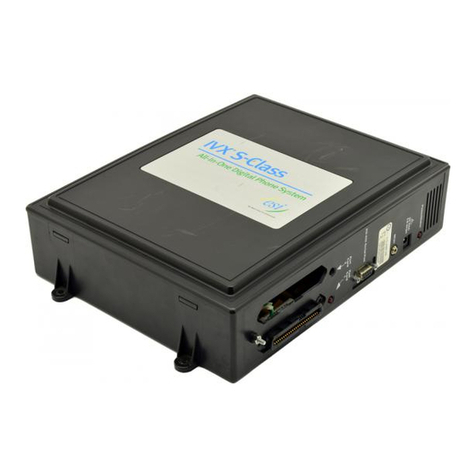
ESI
ESI IVX S-Class User manual
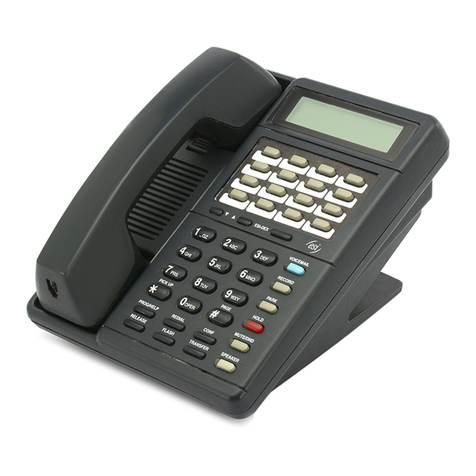
ESI
ESI IVX 128 User manual

ESI
ESI IVX S-Class Operating and safety instructions

ESI
ESI IVX C-Class User manual

ESI
ESI eSIP Evolution Series User manual

ESI
ESI dPhone4 User manual
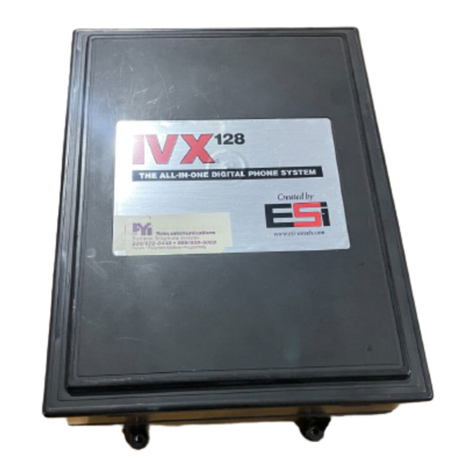
ESI
ESI IVX 128 Plus Installation and operation manual
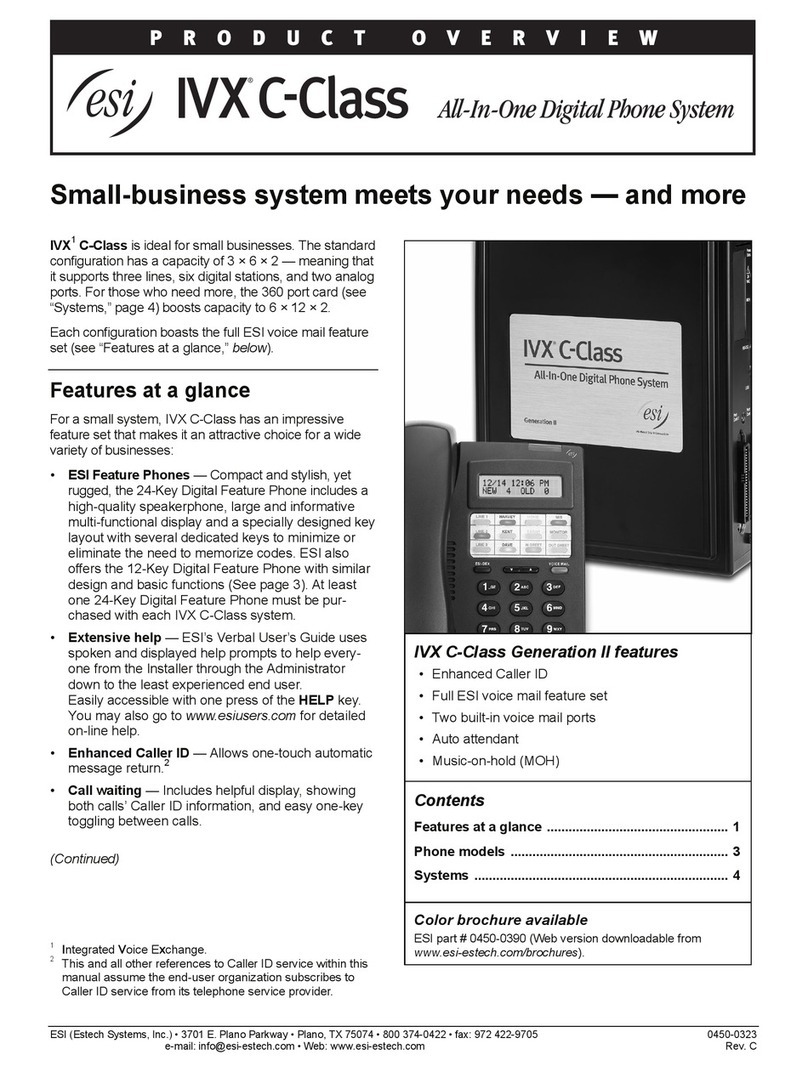
ESI
ESI IVX C-Class Operating and safety instructions
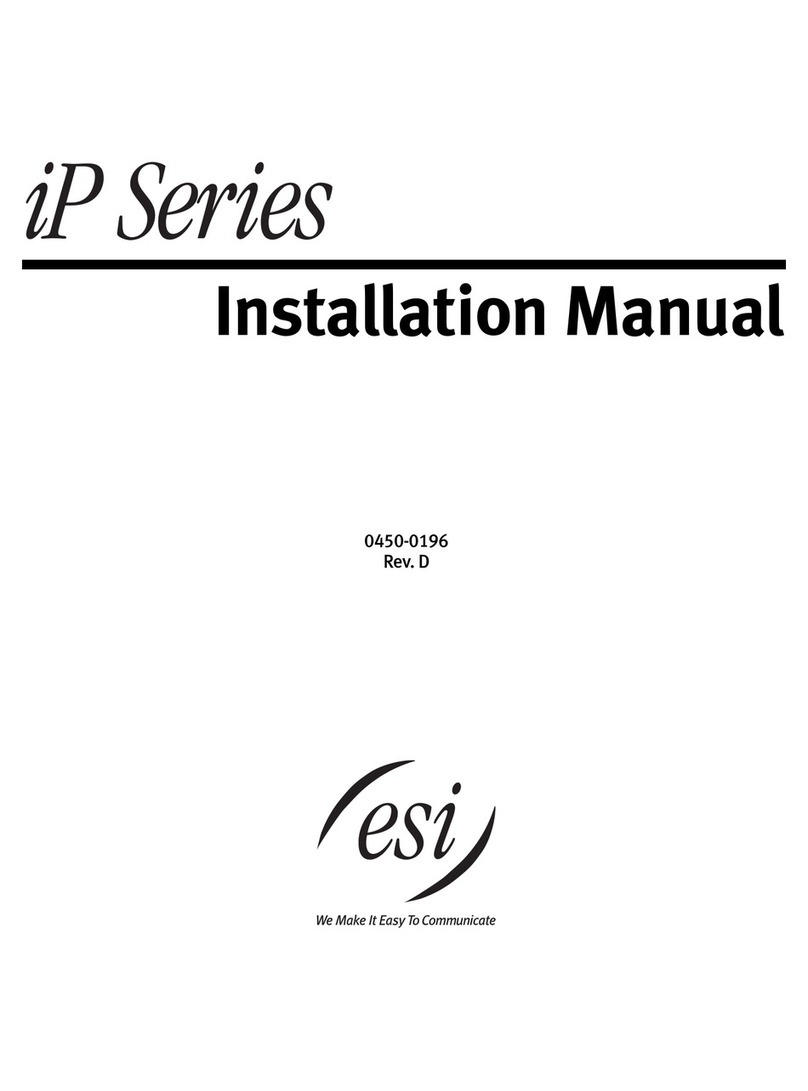
ESI
ESI IP 200 User manual
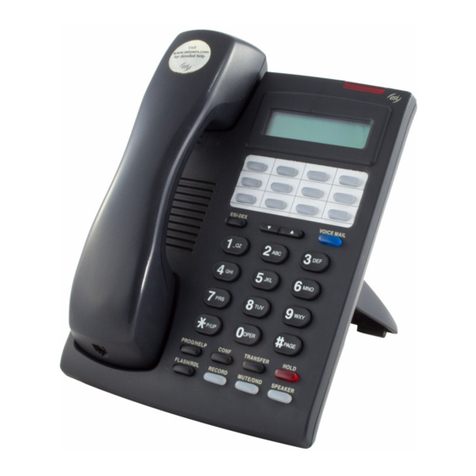
ESI
ESI Feature Phone User manual
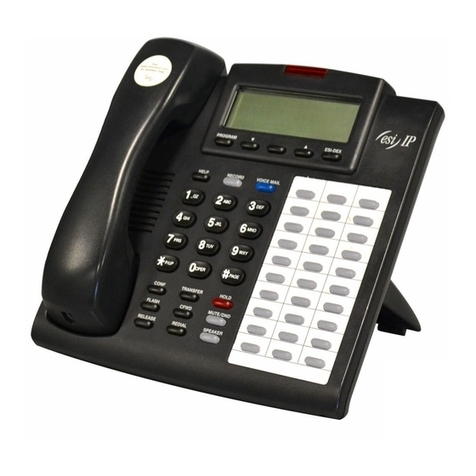
ESI
ESI Feature Phone User manual
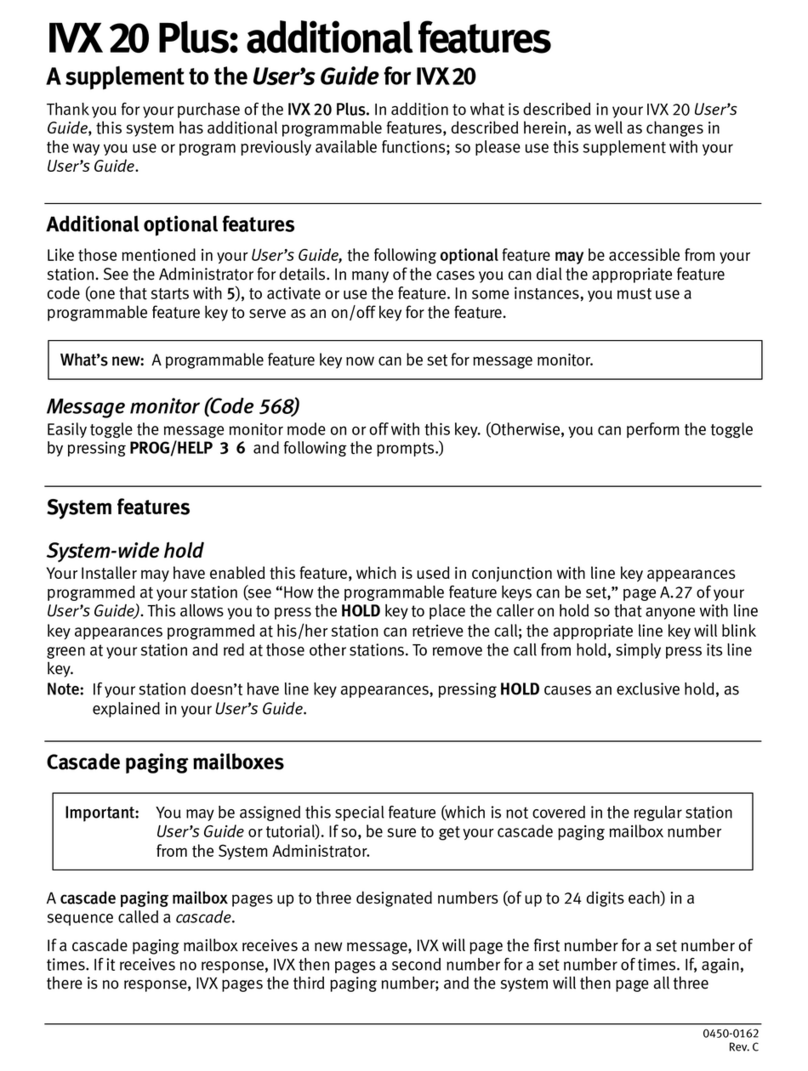
ESI
ESI IVX 20 Plus Owner's manual




